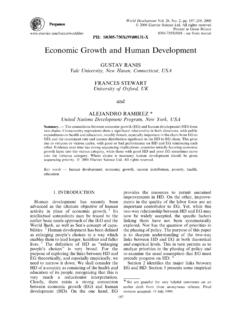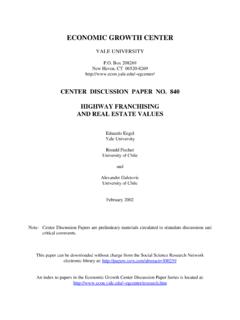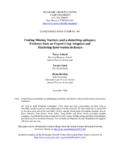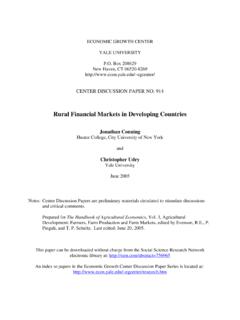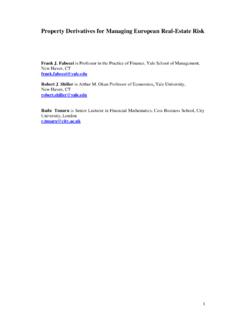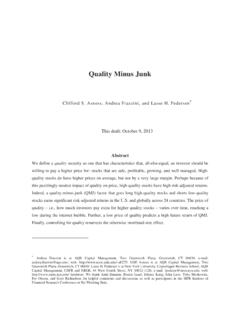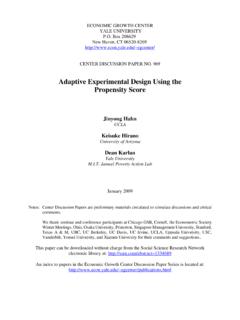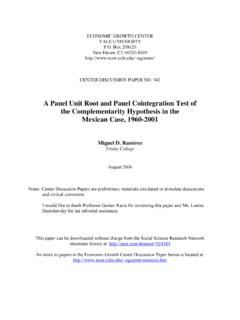Transcription of ECONOMIC GROWTH CENTER YALE UNIVERSITY
1 ECONOMIC GROWTH CENTER yale UNIVERSITY Box 208269 New Haven, CT 06520-8269 ~egcenter ECONOMIC GROWTH CENTER Discussion Paper No. 1033 Economics Department Working Paper No. 125 Targeting Ultra-poor Households in Honduras and Peru Dean Karlan yale UNIVERSITY Bram Thuysbaert* KU Leuven Department of Economics October 2013 Notes: CENTER discussion papers are preliminary materials circulated to stimulate discussion and critical comments. * Contact information: Dean Karlan yale UNIVERSITY , Innovations for Poverty Action, and the Jameel Poverty Action Lab) and Bram Thuysbaert yale UNIVERSITY , Ghent UNIVERSITY , and Innovations for Poverty Action).
2 We thank Ford Foundation for funding; PLAN International, PLAN-Honduras, ODEF Social, PLAN-Peru and Asociaci n Arariwa for collaboration on the underlying implementation; and, CGAP for collaboration on the overall initiative. Authors retained full intellectual freedom throughout the study. We thank Jennifer Severski, Adam Kemmis Betty, Maria Dolores Sanchez Liste, Juan Manuel Hern ndez-Agramonte, Edgar Salgado, Yann Guy, Andrew Hillis, Maria Dieci and Nathanael Goldberg, for project management, field support and data analysis support. All errors and opinions are those of the authors. This paper can be downloaded without charge from the Social Science Research Network Electronic Paper Collection.
3 Targeting ultra-poor households in Honduras and Peru Dean Karlan Bram Thuysbaert* Abstract For policy purposes, it is important to understand the relative efficacy of various methods to target the poor. Recently, participatory methods have received particular attention. We ex-amine the effectiveness of a hybrid two-step process that combines a participatory wealth ranking and a verification household survey, relative to two proxy means tests (the Progress out of Poverty Index and a housing index), in Honduras and Peru. The methods we examine per-form similarly to one another by various metrics.
4 They all target most accurately in the cases of the poorest and the wealthiest households but perform with mixed results among households in the middle of the distribution. Ultimately, given similar performance, the analysis suggests that costs should be the driving consideration in choosing across methods. JEL: C81; O12; O20 Keywords: poverty targeting; participatory wealth rankings; proxy means tests * Contact information: Dean Karlan yale UNIVERSITY , Innovations for Poverty Action, and the Jameel Poverty Action Lab) and Bram Thuysbaert yale UNIVERSITY , Ghent UNIVERSITY , and Innovations for Poverty Action).
5 We thank Ford Foundation for funding; PLAN International, PLAN-Honduras, ODEF Social, PLAN-Peru and Asociaci n Arariwa for collaboration on the underlying implementation; and, CGAP for collaboration on the overall initiative. Authors retained full intellectual freedom throughout the study. We thank Jennifer Severski, Adam Kemmis Betty, Maria Dolores Sanchez Liste, Juan Manuel Hern ndez-Agramonte, Edgar Salgado, Yann Guy, Andrew Hillis, Maria Dieci and Nathanael Goldberg, for project manage-ment, field support and data analysis support. All errors and opinions are those of the authors.
6 1 Introduction Effectively identifying the appropriate recipients for aid programs is critical in order to max-imize social impact with scarce resources. The erroneous inclusion of a household that is not part of the target population generally means resources wasted. Yet effective targeting is not costless. In theory, the economics are straightforward: screen such that the marginal cost of screening out the marginal ineligible participant is equal to the wasted resources transferred as a result of mistargeting. Targeting poor households is difficult because the criteria for eligibility may be hard both to define and to verify.
7 As there is no single defining characteristic of poverty, criteria for eligibility tend to be multidimensional and subject to much debate. Poverty lines based on per capita income or expenditure are often used, but it is also well recognized that they have limitations and represent a simplification of what it means to be poor (Ravallion 1998; Bebbington 1999; Alwang, Siegel, and Jorgensen 2001). Once the relevant criteria are defined, verifying that certain households meet those criteria poses its own challenges. Measuring income for poor families, for example, is notoriously chal-lenging: it derives mostly from informal sources and is often in kind rather than monetary (Dea-ton 1997).
8 Verification may be further complicated when respondents, wishing to participate in the program, perceive an incentive to misreport information related to their eligibility. Such challenges may create a trade-off between accuracy and cost in identifying eligible households. The challenges of verification require cost-effective solutions to targeting particular house-holds. Three methods have been broadly proposed as solutions (Coady, Grosh, and Hoddinott 2002). First is geographic targeting, which uses national or regional poverty maps to select eli-gible households by region.
9 While typically less precise relative to other methods, geographic targeting may suffice as an inexpensive and quick method in certain circumstances. Even when other selection methods are used, geographical targeting is often applied as a first filter. A second method is a proxy means test (PMT), in which field workers collect demographic, asset or housing information that can be used to approximate a household s poverty status. Com-pared to measurements of income or consumption, the inputs required for a PMT are both quicker to collect and easier to verify.
10 However, for any PMT there is a substantial risk of target-ing error. Moreover, PMTs typically lack transparency, potentially leading to accusations of fa-voritism or incompetence, which could undermine the legitimacy of the program. A third me-thod is selection by village members themselves. The criteria for selection can range from nom-ination by local leaders to ranking through a Participatory Wealth Ranking (PWR). A PWR invites 2village members to rank members of their community according to poverty levels. The poorest members, typically, are then eligible for the program.
